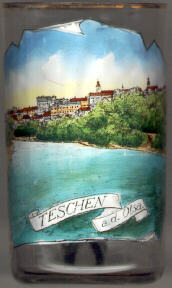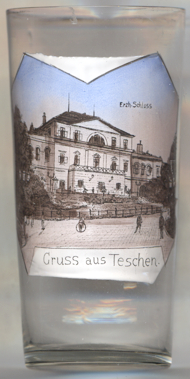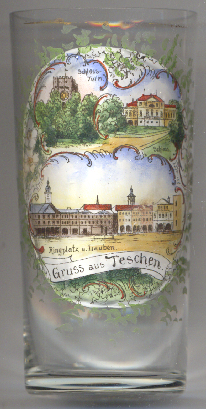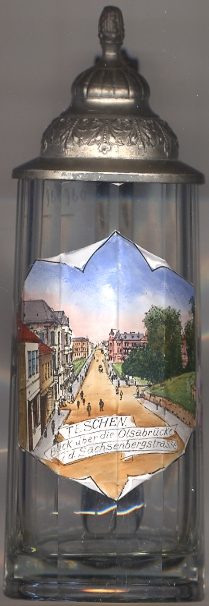

|
| POLSKA | POLAND |
| województwo: Śląskie | voivodship: Silesia |
| powiat: Cieszyn | county: Cieszyn |
Cieszyn (German: Teschen, Czech: Těšín) is situated at an elevation of 379 m on the right bank of the river Olza (Czech: Olše, German: Olsa), which here formes the border between Poland and the Czech Republic. Across the river lies the Czech town of Český Těšín, once part of the historic town. The municipality of Cieszyn has a population of about 32,900 (2023).
 The area has been populated by West Slavic peoples since at least the 7th century. According to legend, in 810 three sons of a prince,
Bolko, Leszko and Cieszko, met here after a long pilgrimage, found a spring, and decided to found a new settlement. The area became part of
the emerging Polish state in the 10th century. The city's oldest surviving buildings date back to the 11th century. The city itself
was first mentioned in documents in 1155. The town was the capital of the Duchy of Cieszyn, established during the fragmentation of Poland into
smaller duchies, since 1290, which was ruled by Piast dynasty until 1653 and by the Habsburg Dynasty of Austria until 1918. The title of Duke of
Teschen was borne by Leopold Joseph of Lorraine from 1722, then by his son Emperor Franz I (Franz Stephan of Lorraine, husband of Maria
Theresia of Austria), then by their daughter Maria Christine and her husband Duke Albrecht von Saxe-Teschen. It was in Teschen that Maria
Theresia of Austria and Friedrich II of Prussia in May 1779 signed the Teschen Peace Treaty, which put an end to the War of the Bavarian
Succession.
The area has been populated by West Slavic peoples since at least the 7th century. According to legend, in 810 three sons of a prince,
Bolko, Leszko and Cieszko, met here after a long pilgrimage, found a spring, and decided to found a new settlement. The area became part of
the emerging Polish state in the 10th century. The city's oldest surviving buildings date back to the 11th century. The city itself
was first mentioned in documents in 1155. The town was the capital of the Duchy of Cieszyn, established during the fragmentation of Poland into
smaller duchies, since 1290, which was ruled by Piast dynasty until 1653 and by the Habsburg Dynasty of Austria until 1918. The title of Duke of
Teschen was borne by Leopold Joseph of Lorraine from 1722, then by his son Emperor Franz I (Franz Stephan of Lorraine, husband of Maria
Theresia of Austria), then by their daughter Maria Christine and her husband Duke Albrecht von Saxe-Teschen. It was in Teschen that Maria
Theresia of Austria and Friedrich II of Prussia in May 1779 signed the Teschen Peace Treaty, which put an end to the War of the Bavarian
Succession.
After the dissolution of the Austro-Hungarian Monarchy, the historic part of the town on the right bank [see glass] became part of Poland (Cieszyn), whereas the new town and the industrial area on the left bank became of part of the Czechoslovak Republic (Český Těšín). After the Treaty of Munich, Český Těšín was occupied by Poland (together with the Czech towns of Karviná, Orlová, Bohumín and Petrovice). In 1939 Cieszyn was occupied by Germany and became part of Upper Silesia (except Český Těšín, which became part of the Protectorate Bohemia and Moravia). Since 1945, the river Olza (Czech: Olše, German: Olsa) again marks the border between Poland (Cieszyn) and the Czechoslovak (today Czech) Republic (Český Těšín).
The Austrian politician Rudolf Ramek (1881–1941; Chancellor of Austria 1924–1926) was born in Teschen / Cieszyn / Těšín.

The  Archducal palace [near left, no. 4660] was built in 1838–1840 in Classicist
style by the Viennese architect Joseph Kornhäusel for Archduke Karl, Duke of Teschen, third son of
Emperor Leopold II. The site had been previously occupied by the upper and lower castles that had been destroyed during the
Thirty Years' War (1618–1648). While the upper castle was removed completely to make room for an English park, the ruins of
the lower castle were rebuild into a residential hunting palace. The palace did not perform its original function. It was rarely visited
by the Habsburgs (who most often stayed in Vienna) and on everyday basis was the seat of the Chamber of Cieszyn, the administration
of the lands owned personally by the Habsburgs in this area. In 1918 the Hunting Palace became the seat of the National Council of the
Duchy of Cieszyn, the first Polish authority in the area of Cieszyn Silesia. Since 1974 a part of the Hunting Palace has been the seat
of the Ignacy Paderewski State School of Music. Since 2005 the remaining part of the palace and a newly build conservatory has served as
the seat of Zamek Cieszyn, a cultural institution that is a design centre.
Archducal palace [near left, no. 4660] was built in 1838–1840 in Classicist
style by the Viennese architect Joseph Kornhäusel for Archduke Karl, Duke of Teschen, third son of
Emperor Leopold II. The site had been previously occupied by the upper and lower castles that had been destroyed during the
Thirty Years' War (1618–1648). While the upper castle was removed completely to make room for an English park, the ruins of
the lower castle were rebuild into a residential hunting palace. The palace did not perform its original function. It was rarely visited
by the Habsburgs (who most often stayed in Vienna) and on everyday basis was the seat of the Chamber of Cieszyn, the administration
of the lands owned personally by the Habsburgs in this area. In 1918 the Hunting Palace became the seat of the National Council of the
Duchy of Cieszyn, the first Polish authority in the area of Cieszyn Silesia. Since 1974 a part of the Hunting Palace has been the seat
of the Ignacy Paderewski State School of Music. Since 2005 the remaining part of the palace and a newly build conservatory has served as
the seat of Zamek Cieszyn, a cultural institution that is a design centre.

Glass no. 4871 [near left] shows pictures of the Archducal Palace [top right] and palace tower
[top left] (see above).
The bottom picture shows a view of the
[https://de.wikipedia.org/wiki/Cieszyn;
https://en.wikipedia.org/wiki/Habsburg_Palace,_Cieszyn, https://en.wikipedia.org/wiki/Cieszyn, https://pl.wikipedia.org/wiki/Cieszyn;
https://en.wikipedia.org/wiki/Archduke_Charles,_Duke_of_Teschen]
 Ringplatz (literally 'Ring Square', today named Rynek ('Market').
Ringplatz (literally 'Ring Square', today named Rynek ('Market').

The picture on glass no. 2843 [near left] shows a view across the bridge over the river (about where the trees are depicted on the right) into the street
 Sachsenberg
Sachsenberg
![[scale]](lineal.jpg)